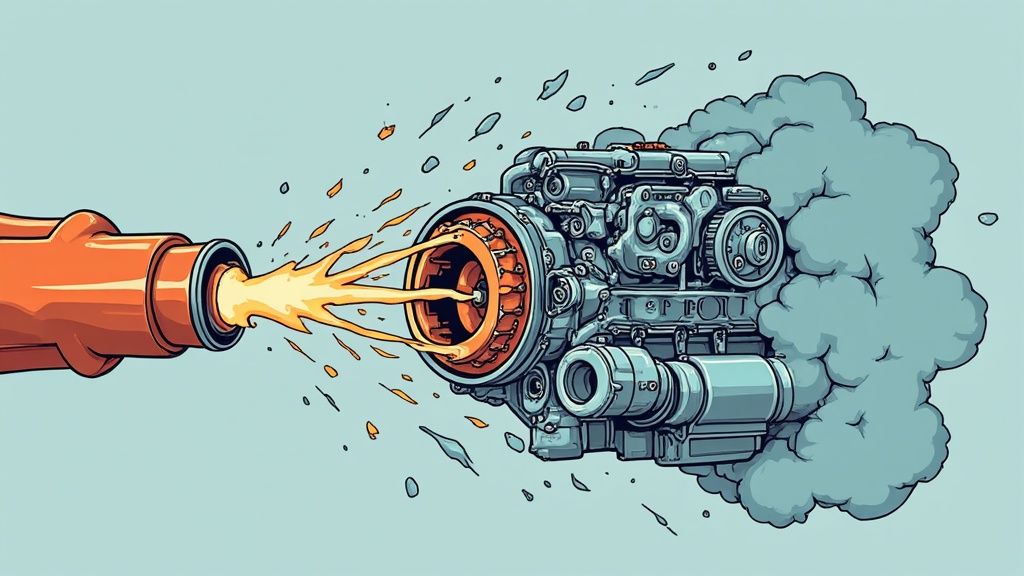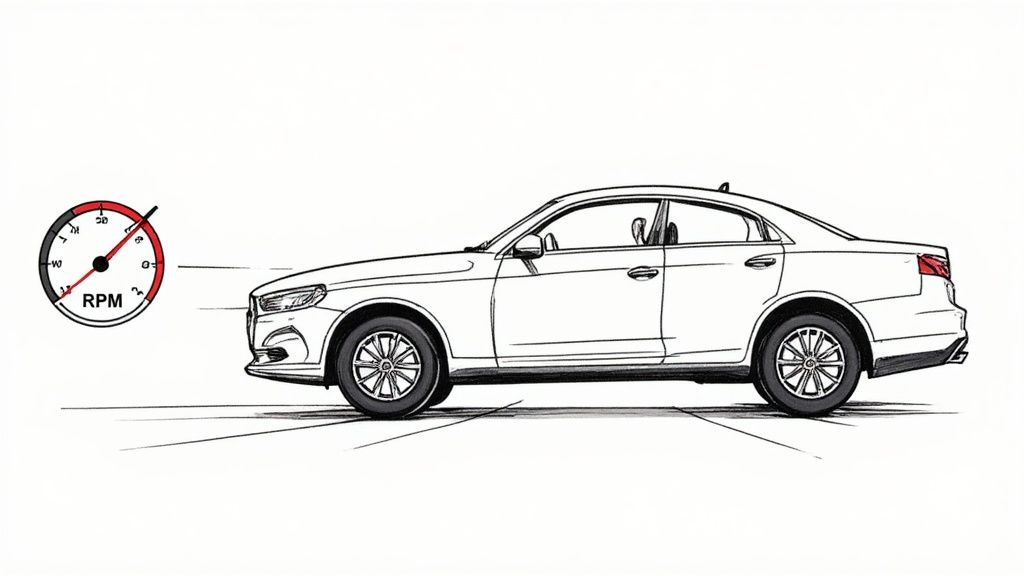
Kwik Kar Service Coupon
Get upto $20 OFF on all services.
Bad spark plug symptoms can signal trouble for your vehicle. This list details six common indicators of failing spark plugs, helping you avoid costly repairs and maintain optimal engine performance. Recognizing these symptoms early is crucial for preserving fuel efficiency and preventing further engine damage. If you experience any of these issues, prompt attention is recommended.
One of the most common and noticeable bad spark plug symptoms is engine misfiring. This occurs when a spark plug fails to ignite the fuel-air mixture within a cylinder at the correct time. This incomplete combustion disrupts the engine's smooth operation, leading to a noticeable jerking, sputtering, or hesitation, particularly when accelerating. The severity of these misfires can vary greatly depending on the number of affected spark plugs and the extent of the damage. A single misfiring spark plug might only cause a slight tremor, while multiple failing plugs can lead to significant power loss and a rough, unstable idle.

Misfiring is a crucial indicator of potential spark plug problems and deserves its place on this list because it directly impacts engine performance, fuel efficiency, and the overall health of your vehicle. Ignoring this symptom can lead to more severe and costly engine damage down the line, including damage to the catalytic converter. Identifying and addressing a misfire quickly is essential for maintaining a healthy and reliable engine.
Features of Engine Misfiring caused by Bad Spark Plugs:
Pros of Recognizing Misfiring as a Symptom:
Cons of Diagnosing Misfiring:
Examples of Engine Misfiring:
Tips for Diagnosing Misfires:
Engine misfiring, as a symptom of bad spark plugs, is a critical warning sign that shouldn't be ignored. Whether you're a Richardson commuter, a family focused on safety, or a fleet manager concerned with vehicle reliability, recognizing and addressing this symptom is crucial for preventing further engine damage and maintaining optimal vehicle performance. Early detection and prompt action can save you time, money, and frustration in the long run.
One of the sneakier bad spark plug symptoms is a noticeable decrease in fuel economy. Your engine relies on spark plugs to ignite the air/fuel mixture in the cylinders. When spark plugs are worn or fouled, this combustion process becomes less efficient. The engine has to work harder and consume more fuel to generate the same power, directly impacting how often you visit the gas station. This inefficiency can lead to a significant drop in fuel economy—up to 30% in extreme cases—making it a potential red flag even before more obvious performance problems surface.

This symptom deserves a place on the "bad spark plug symptoms" list because it's often an early warning sign, and addressing it quickly can save you money at the pump and prevent more serious issues down the road. Specifically, declining fuel economy due to faulty spark plugs is characterized by gradually decreasing gas mileage and more frequent refueling. Your engine's computer might even adjust the fuel mixture to compensate for the inefficient combustion, further masking the underlying problem. This is especially relevant for our target audience of Richardson commuters, families, and fleet managers concerned about operating costs. For military personnel, first responders, and healthcare workers utilizing service discounts, identifying and addressing this issue promptly can maximize those savings. Similarly, owners of aging or high-mileage vehicles prone to spark plug issues can benefit from this early detection.
Examples of this in action:
Pros of using fuel economy as a diagnostic indicator:
Cons of relying solely on fuel economy:
Actionable tips for diagnosing bad spark plugs through fuel economy:
While Consumer Reports fuel economy testing and EPA fuel economy estimates have popularized tracking mileage, applying this practice to your own vehicle is crucial for early detection of bad spark plug symptoms. By actively monitoring your fuel consumption, you can stay ahead of potential problems and keep your vehicle running efficiently.
One of the most common and frustrating bad spark plug symptoms is difficulty starting your vehicle. A healthy engine relies on strong, consistent sparks from the spark plugs to ignite the air-fuel mixture and initiate the combustion process. When spark plugs are worn, fouled, or damaged, they struggle to generate the necessary spark, making it difficult or even impossible for the engine to start. This symptom often manifests as prolonged cranking before the engine finally "catches," or in more severe cases, a complete "click-no-start" condition where the engine doesn't turn over despite the starter motor functioning properly. This is particularly pronounced in cold weather, as the lower temperatures make ignition more challenging.

Difficulty starting deserves a prominent place on this list of bad spark plug symptoms because it directly impacts a vehicle's core functionality and can quickly escalate into a major inconvenience. Specific features of this symptom include extended cranking times, click-no-start scenarios, increased difficulty in cold weather, rapid battery drain from repeated start attempts, and often worsened starting performance after the vehicle sits overnight. For commuters in Richardson, TX, consistent starting is crucial for reliable daily travel, making this a symptom that needs immediate attention. Similarly, families, military personnel, first responders, healthcare workers, and small business fleet managers all rely on dependable vehicles, and difficulty starting poses a significant disruption. Owners of older or high-mileage vehicles in Richardson, TX, are particularly susceptible to this issue due to the natural wear and tear on spark plugs over time.
Pros of recognizing this symptom:
Cons of this symptom:
Examples of Difficulty Starting:
Actionable Tips:
Suspect a starter issue? Learn more about Difficulty Starting to differentiate between starter and spark plug problems. This is especially valuable for Richardson residents who want to ensure they are addressing the correct issue and receiving appropriate service from their auto repair shop.
A rough idle is one of the most common bad spark plug symptoms, indicating an uneven or unstable engine operation when your vehicle is stationary. Faulty spark plugs disrupt the combustion process, making it inconsistent and causing the engine to struggle at idle. This translates to noticeable vibrations, fluctuating RPM readings on your dashboard, and a general feeling that the engine is struggling to maintain a steady rhythm. You might even feel the entire vehicle shaking or vibrating while stopped. The tachometer (RPM gauge) might bounce erratically, confirming the unevenness of the engine's operation.

This symptom deserves a place on the list of bad spark plug symptoms because it's often one of the earliest and most noticeable indicators of a problem. For Richardson commuters, families, military personnel, first responders, healthcare workers, and small business fleet managers alike, a rough idle can be a warning sign that shouldn't be ignored. Specifically, the features of a rough idle caused by bad spark plugs include noticeable engine vibration at a standstill, a fluctuating RPM gauge, uneven or irregular engine sounds, occasional stalling, and increased noticeable vibrations when the A/C or other accessories are turned on. The benefit of recognizing this symptom is that it's often easily noticeable without any special tools and can be initially checked by simply observing the tachometer. For owners of aging or high-mileage vehicles in particular, this can be a valuable early warning sign.
For example, you might see your engine RPM fluctuating between 500-1000 RPM at idle, feel your steering wheel vibrating when stopped at a traffic light, or hear the engine struggling and sounding like it might stall. While a rough idle can be subtle in its early stages and might be dismissed by inexperienced drivers as normal engine behavior, it's crucial to pay attention to these signs.
Pros of using rough idle as a diagnostic indicator:
Cons of using rough idle as a sole diagnostic indicator:
Actionable Tips:
Recognizing a rough idle and understanding its connection to bad spark plugs can save you time, money, and potential headaches down the road. Learn more about Rough Idle and other vehicle inspection essentials. Don't hesitate to seek professional advice if you suspect your spark plugs are causing a rough idle. Early diagnosis and repair can prevent more significant engine problems and ensure your vehicle runs smoothly and efficiently.
Engine surging or hesitation is a noticeable bad spark plug symptom that can significantly impact your driving experience and even pose safety risks. This occurs when your engine's power delivery becomes inconsistent, causing the vehicle to unexpectedly accelerate (surge) or briefly lose power (hesitate) during steady driving. This erratic behavior stems from the spark plugs intermittently failing to ignite the fuel-air mixture in the cylinders. When a spark plug doesn't fire correctly, the resulting misfire disrupts the smooth power delivery, leading to the surging or hesitation you feel.
This inconsistent firing creates unpredictable power delivery. Imagine merging onto a busy highway and experiencing a sudden loss of power – a dangerous scenario caused by faulty spark plugs. Similarly, unexpected surges in speed can be equally unsettling and hazardous. This symptom is usually worse when the engine is under load, such as when accelerating, climbing a hill, or towing, or within specific RPM ranges. It can sometimes feel like there's an intermittent problem with your gas pedal connection. This often happens during steady-state cruising, where you maintain a constant speed.
Several features characterize engine surging or hesitation:
Why this is a key bad spark plug symptom: Engine surging and hesitation directly indicate a problem within the ignition system, often pointing to worn or faulty spark plugs. It's a distinct symptom that helps narrow down the potential causes of engine performance issues.
Pros of recognizing this symptom:
Cons of this symptom:
Examples of Engine Surging/Hesitation:
If you experience a jerking sensation specifically during acceleration, it's worth noting that while this can be another indicator of failing spark plugs, other factors might be involved. For more information on this and other potential causes related to a jerking sensation while accelerating, check out this helpful resource: car jerks when accelerating
Tips for Dealing with Engine Surging or Hesitation:
By understanding the characteristics, causes, and implications of engine surging or hesitation, you can address this bad spark plug symptom promptly and ensure safe and reliable vehicle operation. Don't hesitate to consult a qualified mechanic for a thorough diagnosis and appropriate repairs.
One of the most common and telling bad spark plug symptoms is the illumination of your vehicle's check engine light (CEL). This seemingly simple dashboard indicator can be a critical early warning system for a variety of engine problems, including failing spark plugs. Understanding how the CEL relates to spark plug health can save you from more extensive and costly repairs down the road.
Your vehicle's computer constantly monitors engine performance using a network of sensors. When a spark plug begins to fail, it disrupts the precise combustion process. This disruption can trigger various fault codes related to misfires, inaccurate oxygen sensor readings, or reduced catalytic converter efficiency. These codes, in turn, activate the CEL. Modern vehicles, especially, are highly sensitive to combustion quality, making the CEL a valuable tool for detecting early signs of bad spark plugs before more serious drivability issues emerge.
Features of a CEL related to Spark Plug Issues:
Pros of relying on the CEL:
Cons of relying on the CEL:
Examples:
Actionable Tips:
The check engine light, alongside its associated diagnostic codes, has become a crucial part of modern vehicle maintenance. Standardized by the OBD-II diagnostic standard and utilized by professional diagnostic tools like Snap-on and Autel, it provides a valuable window into engine health. Paying attention to this seemingly simple light can significantly extend the life of your vehicle and prevent costly repairs, making it a vital indicator of bad spark plug symptoms. Ignoring it could lead to more significant problems, especially for owners of aging or high-mileage vehicles who might be more susceptible to such issues.
| Symptom | Implementation Complexity 🔄 | Resource Requirements ⚡ | Expected Outcomes 📊 | Ideal Use Cases 💡 | Key Advantages ⭐ |
|---|---|---|---|---|---|
| Engine Misfiring | Medium – requires OBD-II scanner & diagnostics | Moderate – diagnostic tools, inspection time | Early detection prevents engine/catalytic damage; uneven engine operation | Diagnosing uneven running and jerking under load | Cylinder-specific codes, early warning |
| Poor Fuel Economy | Low – tracking fuel logs and mileage | Low – mostly observational and log tracking | Noticeable drop in MPG; increased fuel consumption | Monitoring fuel efficiency and early inefficiency signs | Quantifiable data, immediate cost savings |
| Difficulty Starting | Medium – inspection of spark plugs and ignition | Moderate – may need spark plug replacement and diagnostic checks | Prolonged engine cranking; possible no-start situations | Troubleshooting cold start or overnight start failures | Clear ignition problem indication |
| Rough Idle | Low – observable without special tools | Low – visual/tactile/aural observation | Uneven and unstable idle; fluctuating RPM | Early detection of combustion inconsistency at idle | Easily noticeable symptom |
| Engine Surging or Hesitation | High – intermittent, needs precise condition testing | Moderate to high – test drives, fuel grade tests | Unpredictable power delivery; dangerous while driving | Identifying intermittent ignition misfires during cruise | Distinct symptom indicating ignition faults |
| Check Engine Light Illumination | Low to Medium – requires OBD-II code reading | Moderate – diagnostic scanner and follow-up repairs | Early fault identification with specific codes | Early detection and targeted spark plug fault diagnosis | Specific codes, early warning, targeted fix |
Recognizing the bad spark plug symptoms we've covered—from engine misfiring and poor fuel economy to difficulty starting and a rough idle—is crucial for maintaining your vehicle's health and performance. Understanding these six key indicators empowers you to address potential problems early, preventing more extensive and costly repairs down the line. Whether you're experiencing engine surging, hesitation, or the dreaded check engine light, knowing the potential cause can save you time, money, and frustration. Mastering these concepts allows you to stay ahead of maintenance needs, ensuring a reliable and efficient commute for Richardson families, military personnel, first responders, healthcare workers, and small business fleet managers alike. Don't let bad spark plugs put a damper on your day.
Keep your vehicle running at its best by addressing bad spark plug symptoms promptly. Kwik Kar Oil Change and Auto Care in Richardson, TX, provides expert diagnostics and reliable spark plug replacement services to get you back on the road quickly and safely. Visit Kwik Kar Oil Change and Auto Care to schedule an appointment today and ensure your engine’s optimal performance.
CLICK LINK BELOW TO LEARN MORE ABOUT OUR SERVICES

Get upto $20 OFF on all services.